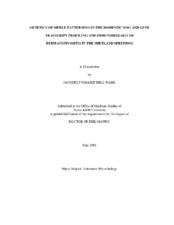| dc.description.abstract | Since its domestication, the dog has served in many roles, from protector, guide, hunter, and best friend, to model organism. Every role in which the dog serves is important; however, this work highlights the importance of the dog as a model organism for study of human hereditary diseases. Roughly half of the 450 hereditary diseases found in the dog have clinical presentations similar to those found in the human. Included in these are auditory-pigmentation conditions and skin diseases for which the dog is a working model. Described herein are studies of the merle coat pattern and dermatomyositis. Through research on these topics, important information can be obtained that can be used to help both the dog and the human. Merle is a pattern of coloring observed in the coat of the domestic dog and is characterized by patches of diluted pigment. Dogs heterozygous or homozygous for the merle locus exhibit a wide range of auditory and ophthalmologic abnormalities. Linkage disequilibrium was identified for a microsatellite marker with the merle phenotype in the Shetland Sheepdog. This region of the human genome contains SILV, a gene important in mammalian pigmentation. Therefore, this gene was evaluated as a candidate for merle patterning. A short interspersed element insertion at the boundary of intron 10/exon 11 was found, and this insertion segregates with the merle phenotype in multiple breeds. These data show that SILV is responsible for merle patterning and is associated with impaired function of the auditory and ophthalmologic systems. Dermatomyositis (DM) is an inflammatory disease of the skin and muscle that occurs most often in the rough collie and Shetland Sheepdog. Gene transcript profiles were generated for affected and normal skin using a canine-specific oligonucleotide array. Two-hundred and eight-five gene transcripts, many of which are involved in immune function, were found to be differentially regulated in these tissues. Also reported are western blot, immunohistochemistry, and immunofluorescence analyses. While our work suggests that canine DM is a disease that may be immune mediated, it did not detect the production of specific disease-associated autoantibodies. | en |


